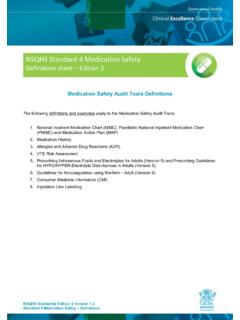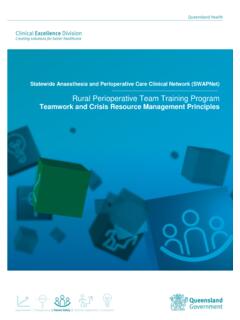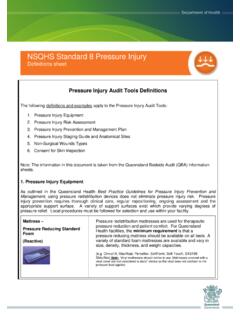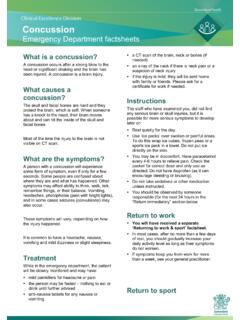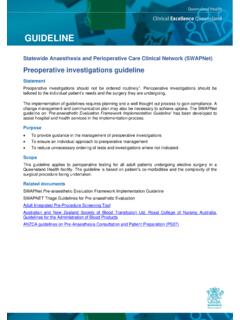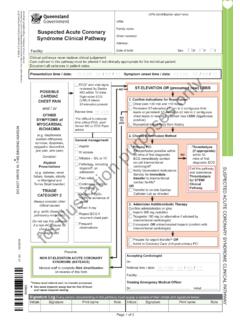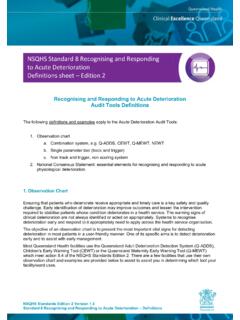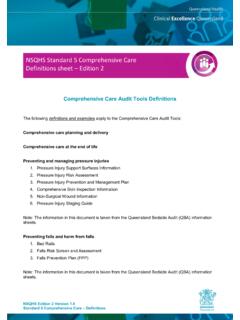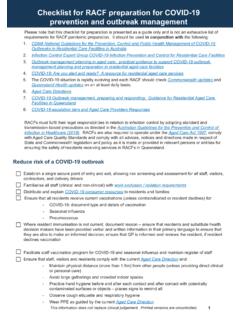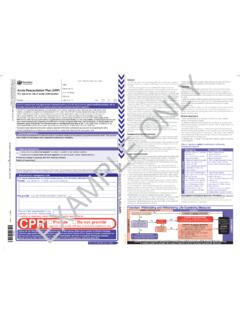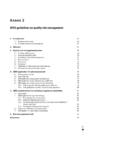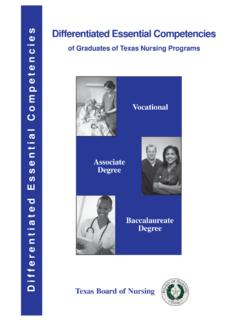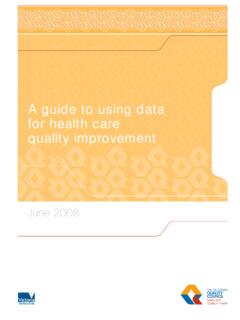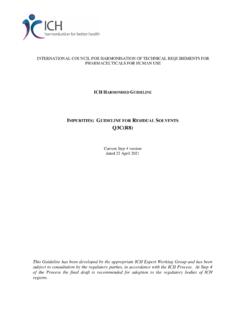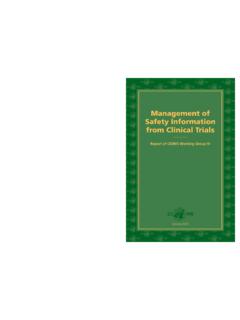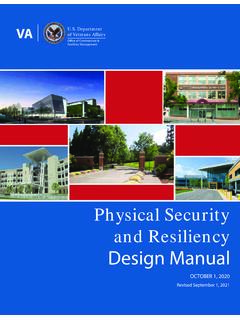Transcription of Best practice guide to clinical incident management ...
1 Department of Health best practice guide to clinical incident management First edition June 2014. Annexure Since the publication of best practice guide to clinical incident management in 2014 there have been several minor changes in the practice of clinical incident management , particularly as it pertains to Queensland Health. This Annexure outlines those changes and is intended to be used together with the best practice guide to clinical incident management . The next edition of the best practice guide to clinical incident management is in progress. Addition of Severity Assessment Code Category In March 2017 the Queensland Health commenced the transition to a new incident management System (RiskMan). With RiskMan an additional Severity Assessment Code, SAC 4 was introduced. A SAC 4 refers to an event that did not cause harm or was a near miss.
2 The severity assessment code matrix (Figure , ) has been updated to incorporate the new category. SAC definitions are: SAC 1 death or likely permanent harm which is not reasonably expected as an outcome of healthcare SAC 2 temporary harm which is not reasonably expected as an outcome of healthcare SAC 3 minimal harm which is not reasonably expected as an outcome of health care SAC 4 no harm or near miss. Changes to Stillbirth reporting On 25 November 2016, an amendment to section 29 (i) of the Hospital and Health Boards Regulation 2012 was approved by the Governor in Council to include stillbirth as a reportable event. The regulation change allows (not mandates) HHSs to conduct a root cause analysis into stillbirths in a legally privileged environment, to determine if there are any improvements that might reduce the risk of preventable stillbirths.
3 It is acknowledged that not all stillbirths are preventable. A guidance document has been prepared by the Queensland Maternal and Perinatal Quality Council to assist HHS executives and clinicians in determining which stillbirths should be considered for clinical incident analysis, for example, RCA and/or other available forms of analysis. Only stillbirths considered a clinical incident must be reported to the Department of Health through the incident management systems. Reporting a stillbirth into the incident management system would be indicated if the stillbirth was not reasonably expected by the treating physicians, mother or family as an outcome of healthcare. Link to here: Queensland Maternal and Perinatal Quality Council webpage Updated: Page 46, Figure : Criteria to consider in selecting an incident analysis method Page 47, Figure : Severity assessment code matrix Page 122, Tip Box: Application of provision Page 123, Figure : A reportable event Page 130 and 141: Removal of word PRIME.
4 best practice guide to clinical incident management Published by the State of Queensland (Queensland Health), May 2014. This document is licensed under a Creative Commons Attribution Australia licence. To view a copy of this licence, visit State of Queensland (Queensland Health) 2014. You are free to copy, communicate and adapt the work, as long as you attribute the State of Queensland (Queensland Health). For more information contact: patient safety and Quality Improvement Service Health Service and clinical Innovation Division Department of Health PO Box 2368. Fortitude Valley QLD 4006 Australia Email: Phone: (+61) (07) 3328 9430. An electronic version of this document is available at 3. Contents Foreword Glossary Section 1. Introduction Introduction and background 12. Purpose and audience13. Key features 13.
5 incident analysis as part of incident management 13. System based analysis vs accountability review 16. The evolution of incident analysis and shared learning 16. Summary of leading practices 18. Section 2. Patient/family/carer perspective incident analysis and management from a patient/family/carer perspective 20. Patient, family and carer centred care first 20. Immediate response or unexpected situations 20. The analysis - what, how and why it happened 21. Following the analysis 22. Partners in building trust relationships 23. Section 3. Before the incident Ensure leadership support 25. Cultivate a safe and just culture 26. Understand essential principals 28. Consistency and fairness 28. Team approach 28. Confidentiality 28. Understand essential concepts 29. The swiss cheese model 29. System 30. System thinking and human factors 30.
6 Complexity 31. Sphere of influence 33. System levels 33. Context 35. Section 4. Immediate response Care for and support of the patient/family/carer/clinicians and others 37. Report incident 37. Secure items 37. Begin the disclosure process 38. Reduce risk of imminent recurrence 39. Section 5. Prepare for analysis Preliminary assessment 41. Methods of incident analysis overview 43. Selecting a method of incident analysis 44. Identify the team and the team approach 49. Coordinate meetings 50. Plan for and conduct interviews 51. Avoiding cognitive traps 52. 4. Section 6. Analysis process Comprehensive analysis 55. Steps in conducting a comprehensive analysis 57. Gathering information 57. Analyse information to identify contributing factors and relationships 59. Use systems theory and human factors 60. Using diagramming 61.
7 Summarise findings 63. Considerations when writing statements of findings 63. Concise analysis 65. Concise incident analysis 66. Concise approach 68. Steps in conducting a concise analysis 69. Multi- incident analysis 71. Multi- incident analysis 72. Examples of multi- incident analysis 74. Steps in conducting a multi- incident analysis 75. Recommended actions 78. Develop and manage recommended actions 79. Develop recommended actions 79. Key features of effective recommended actions 79. Suggest an order of priority for recommended actions 83. Strength of recommendation/s 85. Consult on draft recommended actions 86. Prepare and hand-off report 86. Manage recommended actions 87. Validate actions from strategic and operational perspectives 87. Delegate recommended actions for implementation and empower implementation 88.
8 Section 7. Follow-through Implement recommended actions 91. Monitor and assess the effectiveness of recommended actions 92. Section 8. Close the loop Close the loop 96. Continuous organisational learning and sharing results 96. Reflecting on and improving the quality of analysis and management processes 98. Conclusion 98. Section 9. References 99. 5. Section 10. Appendices A Analysis team membership, roles and responsibilities 107. B Decision making for community about health incidents 109. C Creating a constellation diagram 110. D incident analysis guiding questions 118. E incident reporting and investigation legislation 121. F Team management checklist 125. G Investigative interview guidance (cognitive type interview) 126. H Case study comprehensive analysis: resident absconds from a long-term care home 128.
9 I Case study concise analysis: medication incident 139. J Three human factors methods that can be used in incident analysis 146. K Lessons learned 150. L Challenges and strategies during the incident analysis process 152. M incident report template 153. N Sample analysis team charter 154. 6. Foreword In healthcare, patient safety incidents that impact the lives of patients and families, as well as clinicians and organisations, can and do occur. In recent years, considerable focus on patient safety has been aimed at different levels the culture of patient safety within healthcare organisations, the knowledge associated with patient safety (methods and research), analysis of safety incidents (with resulting learning and improvements) and sharing and communicating these learnings with others. Greater understanding of the complexities and limitations of healthcare have also surfaced such as interconnections between services and care, resource demands to implement improvement initiatives, increased visibility of patient safety and the impact of stringent budgets on quality of care.
10 This guide to best practice clinical incident management has been developed as a resource to support those responsible for, or involved in, managing, analysing and learning from patient safety incidents in any healthcare setting. This guide aims to increase the effectiveness of analysis in enhancing the safety and quality of patient care, by providing methods and tools to assist in answering the following questions about each patient safety incident : What happened? How and why it happened? What can be done to reduce the likelihood of recurrence and make care safer? What was learned? How can the learning be shared? Key enhancements to the guide from previous policy and standards include: the patient/family perspective multiple methods of analysing incidents a description of how analysis is intertwined with the incident management continuum an innovative diagramming method to better identify contributing factors and their interconnections a new section on developing, prioritising, validating and managing recommended actions.
